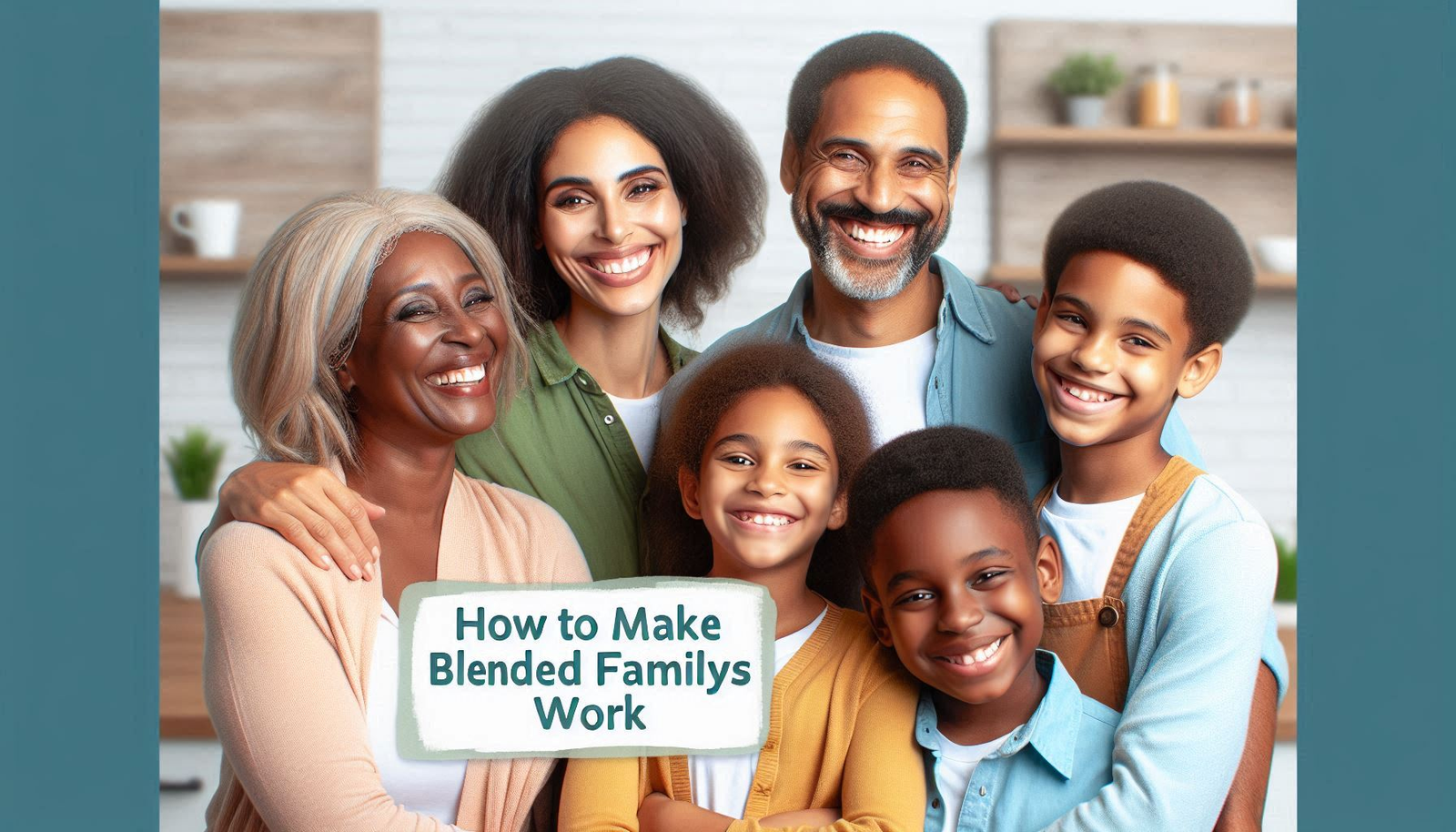Blended families, also known as stepfamilies or complex families, are families that are formed when two people with children from previous relationships get married or cohabit. Blended families are becoming more common in today’s society, as divorce, remarriage, and cohabitation rates increase. According to the U.S. Census Bureau, about 16% of children live in blended families, and this number is expected to grow in the future.
Blended families can offer many benefits, such as providing more love, support, and stability for the children and the parents. However, blended families can also face many challenges, such as adjusting to new roles, relationships, and routines, dealing with conflicts, and coping with emotions. Blended families can take time and effort to work, but they can also be rewarding and fulfilling.
In this article, we will offer some tips on how to make blended families work, based on research and expert advice. These tips are not meant to be exhaustive or prescriptive, but rather to serve as general guidelines that can be adapted to different situations and needs. By following these tips, you can help your blended family overcome the difficulties and enjoy the advantages of being a blended family.
Tip 1: Communicate openly and respectfully

Communication is essential for any family, but especially for blended families. Communication can help you understand each other’s feelings, thoughts, and needs, as well as resolve issues and prevent misunderstandings. Communication can also help you bond and build trust with each other, as well as express your love and appreciation.
To communicate effectively with different members of your blended family, you need to be open and respectful. This means being honest, clear, and constructive, as well as listening, empathizing, and validating. You also need to be respectful of each other’s opinions, preferences, and styles, as well as avoid blaming, judging, or interrupting.
Some tools and strategies that can facilitate communication in your blended family are:
- Family meetings: Family meetings are regular gatherings where you can discuss important matters, such as rules, schedules, plans, and problems. Family meetings can help you share information, make decisions, and solve conflicts as a team. Family meetings can also help you celebrate achievements, give compliments, and have fun as a family.
- Ground rules: Ground rules are basic principles that guide your communication and behavior in your blended family. Ground rules can help you establish expectations, boundaries, and respect in your blended family. Some examples of ground rules are: be polite, be honest, be supportive, and be responsible.
- Active listening: Active listening is a skill that involves paying attention, reflecting, and responding to what the other person is saying. Active listening can help you show interest, understanding, and empathy to the other person, as well as clarify any confusion or misunderstanding. Active listening can also help you avoid arguments, interruptions, and distractions.
Tip 2: Respect each other’s boundaries and roles

Respecting boundaries and roles is important for blended families, as it can help you maintain your individuality, autonomy, and identity, as well as avoid interference, criticism, or comparison. Boundaries and roles can also help you define your responsibilities, obligations, and rights in your blended family, as well as respect those of others.
To respect each other’s boundaries and roles, you need to be aware, flexible, and cooperative. This means being aware of your own and others’ boundaries and roles, such as personal space, privacy, belongings, and relationships. It also means being flexible and willing to adjust your boundaries and roles as needed, such as when changes occur, new situations arise, or conflicts emerge. It also means being cooperative and supportive of each other’s boundaries and roles, such as by asking for permission, giving consent, and offering help.
Some ways to establish and maintain healthy boundaries and roles in your blended family are:
- Discussing expectations: Discussing expectations is a process where you communicate your needs, wants, and hopes for your blended family, as well as listen to those of others. Discussing expectations can help you align your visions, goals, and values for your blended family, as well as avoid disappointment, frustration, or resentment. Discussing expectations can also help you negotiate, compromise, and agree on your boundaries and roles in your blended family, such as who does what, when, and how.
- Defining responsibilities: Defining responsibilities is a process where you assign tasks, duties, and chores to different members of your blended family, based on their abilities, interests, and availability. Defining responsibilities can help you distribute the workload, share the burden, and increase the efficiency in your blended family. Defining responsibilities can also help you foster accountability, reliability, and teamwork in your blended family, as well as reward and recognize each other’s contributions.
- Setting consequences: Setting consequences is a process where you establish the outcomes of following or breaking the rules, boundaries, and roles in your blended family, such as rewards, punishments, or feedback. Setting consequences can help you reinforce positive behavior, discourage negative behavior, and correct mistakes in your blended family. Setting consequences can also help you teach lessons, impart values, and promote growth in your blended family, as well as ensure fairness, consistency, and transparency.
Tip 3: Build trust and rapport

Building trust and rapport is crucial for blended families, as it can help you create a strong, lasting, and meaningful bond with each other. Trust and rapport can also help you feel safe, comfortable, and confident with each other, as well as cope with stress, challenges, and changes. Trust and rapport can also help you enhance your happiness, satisfaction, and well-being in your blended family.
To build trust and rapport with different members of your blended family, you need to be caring, attentive, and appreciative. This means being caring and showing your love, affection, and support to each other, such as by giving hugs, kisses, and compliments. It also means being attentive and showing your interest, curiosity, and respect to each other, such as by asking questions, listening, and remembering. It also means being appreciative and showing your gratitude, recognition, and admiration to each other, such as by saying thank you, giving gifts, and celebrating.
Some activities and gestures that can foster trust and rapport in your blended family are:
- Spending quality time: Spending quality time is an activity where you dedicate some time to be with each other, without any distractions, interruptions, or obligations. Spending quality time can help you have fun, relax, and enjoy each other’s company, as well as learn more about each other’s personalities, hobbies, and stories. Spending quality time can also help you create memories, experiences, and connections that can strengthen your bond and relationship.
Tip 4: Support each other’s growth and development

Supporting each other’s growth and development is beneficial for blended families, as it can help you enhance your skills, talents, and potentials, as well as achieve your goals and aspirations. Supporting each other’s growth and development can also help you boost your self-esteem, confidence, and happiness, as well as inspire, motivate, and encourage each other. Supporting each other’s growth and development can also help you enrich your lives, experiences, and opportunities in your blended family.
To support each other’s growth and development, you need to be encouraging, helpful, and constructive. This means being encouraging and showing your enthusiasm, optimism, and praise to each other, such as by cheering, clapping, and complimenting. It also means being helpful and showing your assistance, guidance, and advice to each other, such as by teaching, mentoring, and coaching. It also means being constructive and showing your feedback, suggestions, and recommendations to each other, such as by reviewing, evaluating, and improving.
Some ways to provide and seek support in your blended family are:
- Encouraging education: Encouraging education is a way to support each other’s academic and intellectual growth and development, such as by pursuing degrees, diplomas, or certificates, taking courses, or reading books. Encouraging education can help you expand your knowledge, improve your skills, and increase your qualifications in your blended family. Encouraging education can also help you explore your interests, passions, and talents in your blended family, as well as discover new ones.
- Fostering hobbies: Fostering hobbies is a way to support each other’s personal and creative growth and development, such as by engaging in activities, sports, or arts that you enjoy, like, or excel at. Fostering hobbies can help you express your personality, creativity, and individuality in your blended family. Fostering hobbies can also help you relax, unwind, and have fun in your blended family, as well as share your hobbies with others or learn new ones.
- Pursuing goals: Pursuing goals is a way to support each other’s professional and social growth and development, such as by setting and achieving objectives, targets, or milestones that are important, meaningful, or challenging for you. Pursuing goals can help you fulfill your dreams, ambitions, and desires in your blended family. Pursuing goals can also help you overcome your fears, doubts, and obstacles in your blended family, as well as celebrate your successes, accomplishments, and rewards.
Tip 5: Celebrate diversity and unity

Celebrating diversity and unity is valuable for blended families, as it can help you appreciate, respect, and embrace each other’s differences, similarities, and uniqueness. Celebrating diversity and unity can also help you create a sense of belonging, identity, and pride in your blended family, as well as foster harmony, peace, and cooperation. Celebrating diversity and unity can also help you enrich your culture, heritage, and traditions in your blended family, as well as learn from each other and grow together.
To celebrate diversity and unity, you need to be curious, open, and inclusive. This means being curious and showing your interest, eagerness, and willingness to learn about each other’s backgrounds, histories, and stories, such as by asking questions, listening, and researching. It also means being open and showing your acceptance, tolerance, and respect for each other’s beliefs, values, and customs, such as by acknowledging, understanding, and appreciating. It also means being inclusive and showing your involvement, participation, and contribution to each other’s events, celebrations, and rituals, such as by joining, supporting, and celebrating.
Some occasions and events to celebrate diversity and unity in your blended family are:
- Holidays: Holidays are special days that commemorate religious, cultural, or historical events, such as Christmas, Hanukkah, Diwali, or Independence Day. Holidays can help you celebrate your faith, culture, or history in your blended family, as well as honor your ancestors, heroes, or leaders. Holidays can also help you share your traditions, foods, or gifts with each other in your blended family, as well as learn about other holidays and their meanings.
- Birthdays: Birthdays are annual celebrations that mark the day of your birth, such as the date, month, or year. Birthdays can help you celebrate your life, age, or personality in your blended family, as well as express your gratitude, love, or wishes. Birthdays can also help you share your cake, cards, or presents with each other in your blended family, as well as learn about other birthday customs and practices.
- Anniversaries: Anniversaries are yearly celebrations that mark the date of a significant event, such as a wedding, a relationship, or a family formation. Anniversaries can help you celebrate your love, commitment, or bond in your blended family, as well as reflect on your memories, experiences, or achievements. Anniversaries can also help you share your flowers, chocolates, or jewelry with each other in your blended family, as well as learn about other anniversary symbols and meanings.
Conclusion

Blended families are families that are formed when two people with children from previous relationships get married or cohabit. Blended families can be challenging, but they can also be rewarding and fulfilling. In this article, we have offered some tips on how to make blended families work, such as communicating openly and respectfully, respecting each other’s boundaries and roles, building trust and rapport, supporting each other’s growth and development, and celebrating diversity and unity. By following these tips, you can help your blended family overcome the difficulties and enjoy the advantages of being a blended family.
If you need more help or guidance on how to make blended families work, you can seek professional help, such as from a therapist, a counselor, or a coach. You can also join support groups, such as online forums, chat rooms, or communities, where you can connect with other blended families and share your stories, challenges, and tips. You can also read more resources, such as books, articles, or blogs, that can provide you with more information, advice, and inspiration on how to make blended families work.
We hope you have found this article helpful and informative. Thank you for reading and good luck with your blended family.
How to Set, Achieve, and Communicate Relationship Goals with Your Boyfriend








